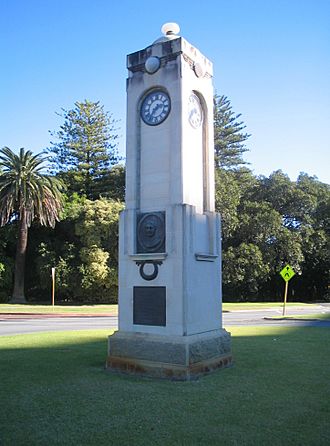Edith Dircksey Cowan Memorial facts for kids
Quick facts for kids Edith Dircksey Cowan Memorial |
|
|---|---|

Edith Dircksey Cowan Memorial at the entrance to Kings Park
|
|
| General information | |
| Type | Memorial |
| Location | Kings Park, Perth, Western Australia |
| Coordinates | Lua error in Module:Coordinates at line 614: attempt to index field 'wikibase' (a nil value). |
| Type | State Registered Place |
| Designated | 5 January 2001 |
| Reference no. | 2232 |
The Edith Dircksey Cowan Memorial is a special clock tower in Perth, Western Australia. You can find it at the entrance to Kings Park. This memorial was built in 1934 to remember Edith Cowan. She was a very important person because she was the first woman ever to be a member of parliament in Australia. The memorial was officially opened on June 9, 1934. It was the first public monument in Australia built to honor an Australian woman.
Contents
What is the Edith Cowan Memorial?
The Edith Dircksey Cowan Memorial stands on a small island in the middle of a road. This spot is right across from the main entrance to Kings Park. The clock tower is about 6 meters (20 feet) tall. It is made from a type of stone called Donnybrook freestone. The building style is called Art Deco, which was popular in the 1920s and 1930s.
Besides a working clock, the memorial has a bronze picture of Edith Cowan's face. There is also a plaque with words that explain why it was built. The plaque says it was put up by people who admired her good work for others. It also mentions her birth and death years (1861–1932) and that she was the first woman in parliament in Australia.
Who Was Edith Cowan?
Edith Cowan was a champion for many important causes. She worked hard to get women's rights and to help women and children who were struggling. She also cared about other social issues.
Edith helped start the King Edward Memorial Hospital for Women. She also co-founded groups like the National Council of Women. In 1920, Western Australia made a law that allowed women to run for parliament. Edith Cowan won a seat in the Western Australian Legislative Assembly. This made her the first woman to serve in any Australian parliament.
How the Memorial Was Built
Edith Cowan passed away on June 9, 1932. Soon after, people wanted to build something to remember her. A group called the Edith Cowan Memorial Committee was formed to raise money.
At first, there was a debate about what kind of memorial to build. Some people wanted something useful, like a hospital ward or a health center. But in the end, everyone agreed on building a monument in Kings Park.
The committee asked the Kings Park Board for permission to build an archway at the park's entrance. However, the Board said no. They felt that the park entrance should be for national memorials only. This made some people feel that Edith Cowan was not seen as important enough.
Later, the committee learned that the Perth City Council was planning a safety zone for people walking near Kings Park. This zone would have a raised platform. In December 1932, the committee asked if they could put a monument there, and the council agreed.
Architect Harold Boas and engineer Henry Atwell designed the monument. Their design was approved in February 1933. A local artist named Margaret Johnson designed the bronze portrait of Edith Cowan.
Debates About the Design
When the design was shared, some groups like the Kings Park Board and architects protested. They thought the chosen spot was too important for just any memorial. They believed it should be saved for something of national importance.
There was also a debate about whether a monument like this was suitable for a woman. Some thought monuments were more for men. But supporters argued that Edith Cowan had achieved great things in a "male domain," so she deserved a monument. This discussion showed some of the unfair ideas about gender at the time.
Despite the debates, the construction went ahead. W. Ogilvy won the contract to build it. Work started in May 1934. The Lieutenant-Governor, James Mitchell, officially opened the memorial on June 9, 1934. This was exactly two years after Edith Cowan's death.
The Memorial Today
The Edith Dircksey Cowan Memorial has stayed in its original spot. It is still in good condition today. In 1996, it was rededicated on the 75th anniversary of Edith Cowan's election to parliament. It stands as a lasting reminder of her important work and her role as a pioneer for women in Australia.
Images for kids




